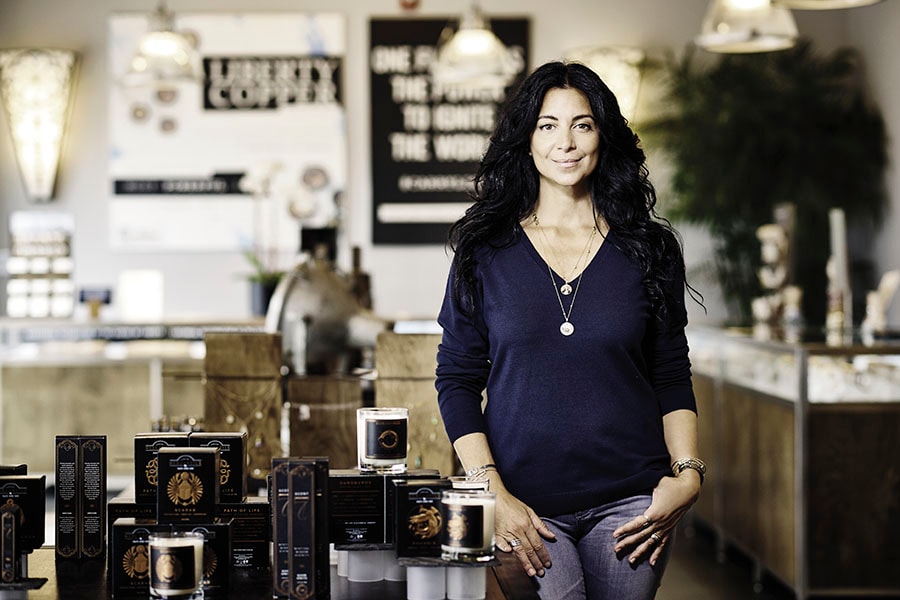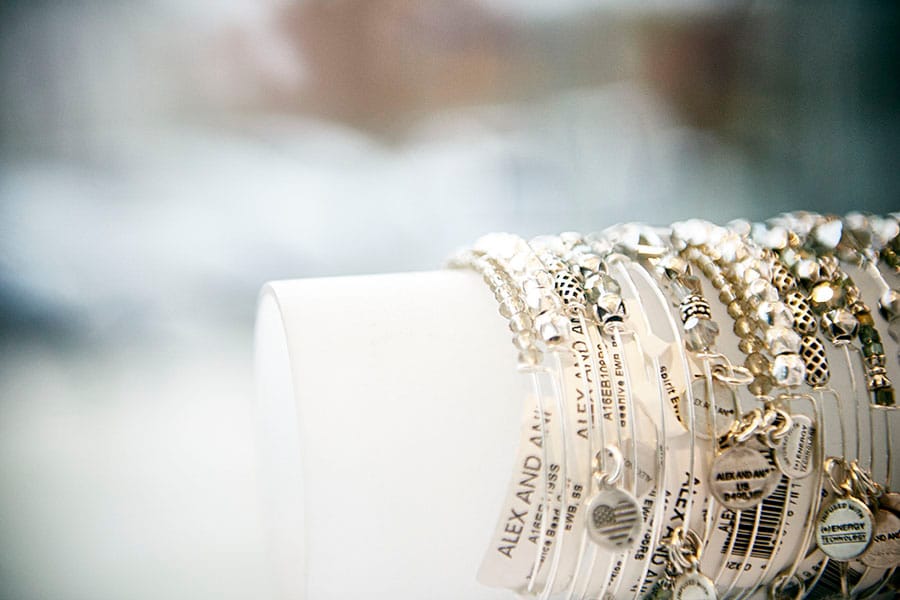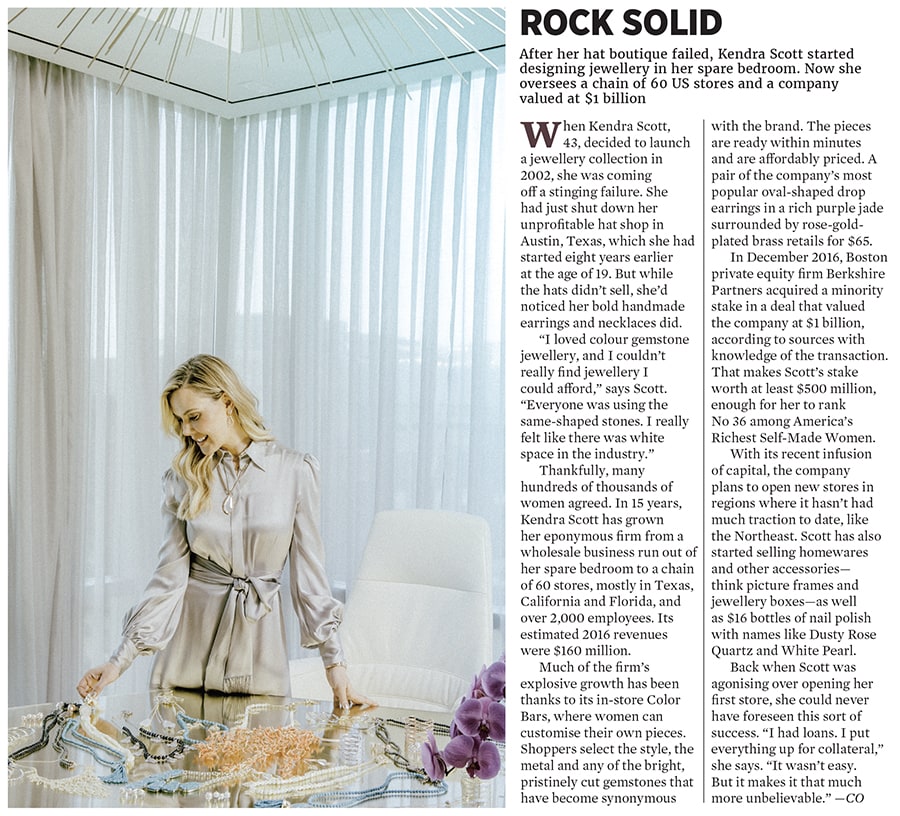
Carolyn Rafaelian: The bangle billionaire
By turning what women wear on their wrists into an affinity statement, Carolyn Rafaelian has grown the hippie brand Alex and Ani into a $1 billion company. Now America's richest jeweller is working on world domination—and maybe an IPO
 Rafaelian in the Alex and Ani store on the first floor of her Cranston, Rhode Island, headquarters, just miles away from her late father’s jewellery factory
Rafaelian in the Alex and Ani store on the first floor of her Cranston, Rhode Island, headquarters, just miles away from her late father’s jewellery factory
Image: Jamel Toppin for Forbes
When Alex and Ani founder and CEO Carolyn Rafaelian walks into a room, you hear her before you see her. She clinks and jangles her way into her office under layers of bracelets, necklaces, cuffs and rings in both precious metals and coated brass, 12 of which she designed herself.
The biggest noise emanates from her celestial-chic jewellery brand’s bestselling products: Charm bangles, of which it has released thousands of iterations, to commemorate lifetime milestones or show off zodiac signs, sports team allegiances, favourite charities and religious totems. Peace, love and big bucks, since these stackable bangles, made from recycled scrap metal, cost customers about $33 apiece—and Rafaelian is moving over 10 million a year.
“It’s not the money that’s the driving force behind this,” Rafaelian says in her Rhode Island accent, which rhymes “force” with “boss”, unable to distract from the math that belies that claim. From its headquarters in unassuming Cranston, Rhode Island, Alex and Ani’s revenues have skyrocketed from $5 million in 2010 to over $500 million in 2016, insiders say, with a net profit margin, according to private equity database Pitchbook, that was recently 23 percent. Rafaelian says she believes each piece is imbued with energy that can have a positive effect on its wearer (she has a priest and a shaman bless her inventory), but her markups on 7½ inches of contorted wire show her to be a master marketer.
“They don’t really sell jewellery,” says Brent Cleaveland, executive director of the Fashion Jewelry & Accessories Trade Association. “They sell positive energy. The bracelet is just a vehicle.” Every Alex and Ani bangle comes with a “meaning card”. A Buddhist om symbol, for example, “signifies God, higher power and the oneness of all beings in life’s cycle”. A simple sailboat charm “bestows peace to its wearer in times of change”. And this universe of good vibes encourages fans of the brand to collect them all. Bangles and bracelets make up 80 percent of total sales; an initiative to use Alex and Ani jewellery as a fundraising tool makes up about 20 percent of total sales, adding another layer of karma—and profits.
That’s how Rafaelian surged from a one-woman band run out of her father’s Rhode Island factory basement into America’s only jewellery billionaire—and the No 18 spot on the Forbes list of America’s Richest Self-Made Women—owning 80 percent of a company worth at least $1.2 billion. She’s enjoying the trappings—fixing up a 56,000-square-foot mansion in Newport that she will open as a museum and testing out new grape varietals at her Sakonnet Vineyards in nearby Little Compton. An IPO awaits. “If I wanted to do that, we’re primed, we’re ready,” she says. “We can pull the switch at any time.”

It’s rare that the public markets ever encounter a CEO like this 50-year-old free spirit, who has been known to consult planetary charts during decision-making. Rafaelian says she was the sort of kid who had an imaginary friend. And while she was raised in the Christian Armenian Apostolic faith, Rafaelian borrows bits and pieces from other religions and traditions. She keeps dried bundles of sage in her office drawer to burn when she needs to smoke out negative energy and a healing quartz crystal on a file cabinet behind her desk.
Not quite everyone’s cup of herbal tea. But Rafaelian’s products let a generation that craves authenticity wear their affinities on their sleeve. “There’s no ambiguity that jewellery like Alex and Ani has become something the consumer covets now,” says Christopher Burch, who backed his former wife Tory, as well as Alex and Ani competitor BaubleBar. “It’s no longer an afterthought. It’s part of her wardrobe.”
Little-known fact: The world’s costume jewellery capital was, for generations, America’s smallest state. Just 30 years ago, roughly 80 percent of that product was made in Rhode Island. Like much of American manufacturing, it’s mostly gone overseas, but Rafaelian traces her roots to this business and this state.
Her father married into the industry, working for his brother-in-law manufacturing brooches and earrings for big names of the age like Trifari and Monet. In 1966, the year Rafaelian was born, he founded his own company, Cinerama Jewelry, based in Cranston, just outside of Providence. He made costume jewellery of all kinds, but this son of Armenian immigrants was best known for American-flag lapel pins he sold wholesale. You can still find Ralph Rafaelian’s badges, with their tiny Swarovski stars and stripes, on eBay.
She and her four siblings were sent to the factory basement as punishment for misbehaving; strong-willed Carolyn remembers hours attaching little paper cards to the backs of ostentatious 1980s earrings. “It was torture,” she says with a laugh. She escaped to the University of Rhode Island, then to the now-defunct for-profit American College for the Applied Arts, before moving to New York City at the age of 22. She worked on her first jewellery line from a Tribeca apartment above a bookstore, scoring small deals with the likes of Bloomingdale’s. Her designs couldn’t have been further from her father’s faux pearls and floral brooches.
“I created what I wanted to wear,” Rafaelian says. “I wanted cocktail rings. I wanted sterling silver.”
At 23, Rafaelian got married. At 25, she had her first daughter, Alex. By the time her second daughter, Ani, came along less than two years later, she had returned to Rhode Island and the stable-if-unsexy costume-jewellery sector, designing private-label earrings and necklaces for mall stalwarts like Bebe, Express and Victoria’s Secret. She took up residence in a corner of Cinerama, her father’s factory. As she was filling $150,000 orders faxed in from New York, Ralph Rafaelian was trying to stay afloat, unable to compete with cheaper Asian manufacturing. “I remember the day that I looked back and I realised that every single person in the factory was working on the orders that I was bringing in,” Carolyn Rafaelian recalls. “In a split second I realised, Oh, my God—they’re counting on me.”
On the side, she continued to dabble with her own label, named after her two eldest daughters. “I was calling out to them, getting their attention—Alex was in her high chair, Ani was probably in a bouncer,” she says. “It was, like, that’s it.”
For over a decade, she kept the family business’s lights on through those unglamorous private-label orders, making six-piece earring sets for $3 that would then sell for $16. Meanwhile, Alex and Ani slowly picked up steam: Rafaelian bought up vintage stones as local companies shuttered, turning them into crystal-adorned bracelets and butterfly hair accessories that cool young things on both coasts sought at Henri Bendel and Fred Segal.
Among her bestsellers: Seamless “endless hoop” earrings, constructed from one piece of wire and able to carry the weight of beads. During one of her many long drives between Manhattan and Rhode Island in the early 2000s, not long after her third daughter was born, she had a career-defining realisation: That design could be applied to a bracelet if she just increased the diameter. “It was after midnight, and I went straight to the factory,” she says.
Rafaelian patented the Alex and Ani 14-gauge expandable wire bangle in 2004; it’s one of about 30 patents the company now holds and the one she most regularly defends in court. “There’s a million sneakers out there, but there’s only one Nike,” she says. An early sample sale at Cinerama was so overrun with shoppers that she called the police for protection. One woman set up a lawn chair four hours before the doors opened. Rafaelian ran into the factory to start putting together charm bracelets herself.
Alex and Ani grew steadily, mostly as a concession in department stores like Bloomingdale’s and Nordstrom. In 2009, she opened its first retail store in Newport. But it was still small-stakes stuff, bringing in less than $5 million in sales, including the wholesale work. Then, at a University of Rhode Island reunion, she met a former state senator with a background in eyewear, Giovanni Feroce, who immediately grasped Alex and Ani’s broader potential.
“It tattoos your body without the tattoos,” says Feroce, who joined as CEO in 2010. To describe the duo as yin and yang is an insult to Taoism. An Iraq war veteran, Feroce speaks like a character in Call of Duty and sought to introduce military precision to a company run on Rafaelian flower power. “I learnt my skill set in high operational tempo during warfare,” he says. “I’d just be literally sitting in Qatar and dreaming of how I could apply it to business.”
The next three years were a whirlwind, as Feroce infused the family business with the kind of professional systems that allowed for growth. The pair raised a war chest courtesy of private equity firm JH Partners, which took a 20 percent stake. (JH Partners cashed out in 2014, flipping the stake to another investor, Lion Capital, in a deal that valued the company at $1 billion.) As they began marketing aggressively, including a Super Bowl ad, their timing couldn’t have been better. ‘Branded’ jewellery, as opposed to nameless wholesale you might grab off a department store rack, was in the process of doubling its market share, to 20 percent, as customers looked to make a statement with their accessories.
“I always say any company that’s faceless has an issue,” says Feroce. “It had a face.” In 2011, a northeastern gift shop chain, the Paper Store, spent $11 million to build Alex and Ani “shop within a shop” concessions at its 72 outlets. “We turned our company upside down,” says Tom Anderson, the Paper Store’s chief operating officer. “Some would call it a risk. But right out of the gate, we couldn’t keep it in stock.”
More big chains like Harvey Nichols and Saks Fifth Avenue began carrying Rafaelian’s bangles. Another master stroke: Licencing deals starting in 2012 with Walt Disney, the National Football League, sororities and, yes, the US military, all of which found that women loved the opportunity to show off their allegiances. With Disney, for example, classic Mickey and Minnie bangles sit alongside newer characters like Elsa from Frozen. (Currently, four of the five bestselling bracelets on the Disney Store’s site are by Alex and Ani.) The company began opening its own stores in top markets like California and New York; by the end of this year, they should number more than 80.

All told, it was a legendary growth spurt, if the company is to be believed. Sales surged from $5 million in 2010, the year Feroce joined, to $230 million in 2013. Through it all, Rafaelian continued to keep every part of the process—from design to casting and soldering to marketing—within a few miles of the company’s Cranston headquarters. Her dad’s Cinerama factory was suddenly humming and expanding exponentially, with row upon row of workers fashioning bangles by hand. Like fine jewellery purveyor Tiffany & Co, Alex and Ani controls its entire supply chain. Says Cleaveland: “They’re skipping the middleman.”
For his efforts, Feroce was pushed out in 2014. “As the company evolved, like many founders, I stepped back into the CEO role,” Rafaelian says vaguely. (Feroce’s successor, Harlan Kent, the former CEO of Yankee Candle, was brought in as president but lasted less than a year, and other senior managers have fled.) Running a company under a founder is always difficult; running a company for one who looks to the stars for guidance, doubly so.
“We got to a point where it was time to move on,” says Feroce, who Forbes believes sold his equity stake back to Rafaelian. He now runs a watch company, Benrus. “I prepped the battlefield. She made the product. We crossed the line of battle,” Feroce says. “Now she’s in active combat. The whole world knows about [Alex and Ani], or if they don’t, they will soon.” Mission accomplished.
One afternoon last November, Rafaelian gathered eight members of her design team in her office, an airy, modern space with a private teak-decked terrace. She sits at the head of a wooden boardroom table dotted with Art Deco sculptures, including a semi-nude dancer with a flapper haircut and a striding marble panther. The women—they’re all women in this meeting, as is most of her workforce—seek approval on, among other things, billboard ads off regional highways; store window displays; the merits of soldering epoxy; the size of loop closures on bracelets; whether some potential models look too young and skinny; and a new licensee, the Wonder Woman franchise. The latest lieutenants in Rafaelian’s revolving door arrived in the past nine months: Cindy DiPietrantonio, a 30-year veteran of apparel giant the Jones Group, and CFO Bob Woodruff, a veteran of Nike.
They have challenges. Fashion is fleeting; customers are fickle. One year’s must-buy is a faux pas the next. Rafaelian must continue to stay ahead of the curve—and of copycats. A big push is abroad; sales outside the US account for only 10 percent of Alex and Ani’s revenues. Rafaelian expects this to double by 2020, which means competing in foreign markets with Pandora, the $12 billion (market cap) Danish sterling silver brand, which operates 2,100 stores worldwide. Like Alex and Ani, its charm bracelets are collectible and ideal for gift-giving, but Pandora’s catalogue differs in that it sells individual charms that each typically costs more than an Alex and Ani brass bangle.
Rafaelian has also launched a slew of products beyond jewellery, including leather clutches and $28 candles. The spiritual ethos always sits at the centre: Its Scent 7 fragrances give its stores a faint smell of lavender and geranium; its $12 body mist is supposed to realign its wearers’ chakras, the Sanskrit term for the human body’s centres of energy. “When you call this a lifestyle company, it’s not because we throw some symbol on a piece of fashion,” she says. “It’s my life.”
That life is reflected across the organisation. Her sister still runs her father’s old factory (which the two siblings now own; he died in 2012). And inside her chic office, Rafaelian points to a worn leather suitcase atop a filing cabinet. It’s all her grandfather took with him when he fled what is now Armenia in 1913, ahead of the genocide there, immigrating through Ellis Island en route to Providence.
Last fall, Rafaelian launched a line partly in homage to her grandfather. A 14-karat-gold pendant from this collection dangles just south of her clavicle. It features a tiny replica of the Statue of Liberty’s torch, surrounded by 50 glinting pavé diamonds—one for every state. The smooth, raised flame is made of copper that was once inside Lady Liberty herself.
She’s already sold tens of thousands of incarnations, thanks to her 2012 purchase of a massive cache of debris discarded after the Statue of Liberty centennial restoration in 1984. Those who know her best would call spending seven figures on 19th-century copper beams classic Carolyn: Impulsive and eyebrow-raising, but ultimately savvy. “I don’t listen,” Rafaelian says. “Which is the best thing I do.”
(This story appears in the 23 June, 2017 issue of Forbes India. To visit our Archives, click here.)














